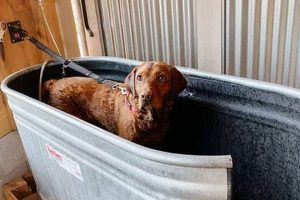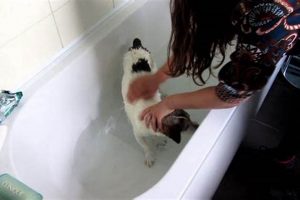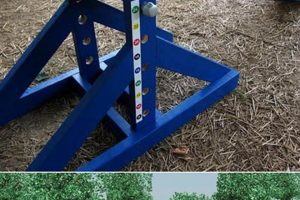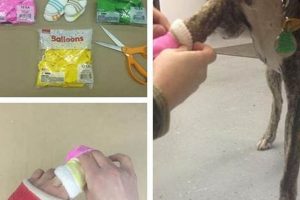The activity of preparing and administering a cleansing wash to a canine companion within a domestic environment, typically using resources readily available to the owner, constitutes a practice with increasing prevalence. This undertaking encompasses all stages from gathering necessary implements like shampoo and towels to the physical act of washing and drying the animal. As an example, a homeowner might utilize a backyard garden hose and a specialized dog shampoo to perform this hygienic procedure.
This approach to pet hygiene offers several advantages, including potential cost savings compared to professional grooming services and the ability to customize the bathing process to accommodate a dog’s specific needs or sensitivities. Historically, owners often relied on natural bodies of water for canine cleansing. Over time, as homes became more equipped with indoor plumbing, the process transitioned to designated areas within the residence. This shift reflects both advancements in living standards and a growing emphasis on pet care.
The subsequent sections will delve into crucial considerations for successful execution, including preparation techniques, selecting appropriate cleaning agents, and employing effective methods for ensuring the animal’s comfort and safety during the procedure. This discussion aims to provide individuals with the information necessary to conduct these activities with confidence and achieve optimal results.
Effective Strategies for Canine Home Cleansing
Achieving a successful and stress-free canine home cleansing experience requires careful planning and attention to detail. Implementing the following strategies can optimize the process and ensure the well-being of the animal.
Tip 1: Select an Appropriate Location: Designate a space that is easily cleanable, minimizes distractions, and prevents escapes. Options include a bathtub, shower stall, or designated outdoor area with secure boundaries.
Tip 2: Gather All Necessary Supplies in Advance: Assemble shampoo specifically formulated for canines, towels, a bathing brush or sponge, a non-slip mat for the bathing area, and any necessary restraint devices, such as a short leash.
Tip 3: Brush the Dog Thoroughly Before Bathing: Remove loose fur and mats prior to wetting the coat. This reduces the likelihood of clumping and facilitates more effective shampoo penetration.
Tip 4: Regulate Water Temperature Carefully: Use lukewarm water to avoid scalding or chilling the animal. Consistently monitor the temperature to maintain a comfortable level throughout the bath.
Tip 5: Apply Shampoo Methodically: Begin by wetting the coat thoroughly. Then, dilute the shampoo according to the manufacturer’s instructions and apply it evenly, working it into a lather from head to tail, avoiding the eyes and inner ears.
Tip 6: Rinse Thoroughly: Ensure all shampoo residue is removed. Inadequate rinsing can cause skin irritation. Rinse until the water runs clear.
Tip 7: Dry the Dog Effectively: Use towels to remove excess water. Consider using a dog-specific dryer on a low heat setting, maintaining a safe distance from the animal’s skin to prevent burns. Monitor the animal’s reaction to the dryer and discontinue use if signs of distress are observed.
Tip 8: Provide Positive Reinforcement: Offer praise and treats throughout the process to create a positive association with bathing.
Adhering to these guidelines promotes a more efficient and less stressful home cleansing experience for both the owner and the animal. The resulting cleanliness contributes to the dog’s overall health and well-being.
The subsequent section will explore specific product recommendations and potential safety concerns related to canine home cleansing.
1. Preparation and Planning
Successful execution of a domestic canine cleansing endeavor hinges upon meticulous preparation and comprehensive planning. This preparatory phase is not merely ancillary but constitutes an integral component, directly impacting the efficacy of the process and the well-being of the animal.
- Resource Acquisition and Organization
Prior to commencing the bath, all necessary resources must be readily available and organized. This includes shampoo specifically formulated for canines, multiple clean towels of appropriate size, a bathing receptacle (tub or basin), a non-slip mat to prevent injury, a water source with adjustable temperature control, and any necessary restraint devices. Failure to assemble these items in advance can lead to delays, increased stress for the animal, and potential safety hazards.
- Environmental Control and Safety Assessment
The chosen bathing environment must be carefully evaluated for potential risks. Sharp objects, slippery surfaces, and extreme temperatures present immediate dangers. Mitigating these risks through proactive measures, such as securing hazardous items, applying non-slip surfaces, and ensuring adequate ventilation, is crucial. The selected location should also be conducive to the animal’s comfort and minimize distractions.
- Canine Temperament and Behavioral Considerations
Understanding the individual canine’s temperament and behavioral tendencies is paramount. Dogs exhibiting anxiety or aggression towards bathing require a tailored approach, potentially involving desensitization techniques or the assistance of a second individual. Pre-bath exercise can help expend excess energy and reduce anxiety. A planned strategy for managing potential behavioral challenges is essential for a safe and positive experience.
- Time Allocation and Process Sequencing
Adequate time must be allocated to complete the bathing process without rushing or causing undue stress to the animal. A well-defined sequence of steps, from pre-bath brushing to post-bath drying, should be established. Rushing through any stage can compromise the quality of the cleansing and increase the likelihood of errors or accidents. A carefully planned timeline allows for adjustments based on the animal’s response and ensures a thorough and gentle cleaning.
In conclusion, thorough preparation and meticulous planning are not merely supplementary steps but fundamental prerequisites for a safe, effective, and positive canine domestic cleansing activity. By addressing resource management, environmental safety, behavioral considerations, and process sequencing, individuals can optimize the experience and promote the animal’s overall well-being throughout the entire procedure. The absence of such planning can result in compromised hygiene, increased stress levels, and potential safety risks for both the animal and the owner.
2. Shampoo Selection Criteria
The act of selecting appropriate shampoo is an elemental determinant of success in domestic canine ablutions. The inherent connection stems from the shampoo’s direct interaction with the animal’s skin and coat, impacting both hygiene and dermatological health. Cause-and-effect relationships are readily apparent; for instance, using a harsh, human-formulated shampoo often results in dermal irritation, while a gentle, dog-specific formula mitigates such risks. The selection process is not merely about surface cleaning but about preserving the delicate balance of the canine epidermis. Consider, for example, a dog with a known allergy to fragrances. The use of a heavily scented shampoo, irrespective of its cleaning efficacy, would trigger an adverse reaction. Hence, the shampoo selection serves as a primary control point in avoiding negative outcomes associated with the overall cleaning activity.
Specific attributes to consider include pH balance, ingredient composition, and coat type suitability. Canine skin possesses a different pH level than human skin, necessitating pH-balanced shampoos specifically formulated for dogs. Ingredients such as artificial dyes and harsh sulfates are often irritants and should be avoided. The individual dog’s coat type dictates the optimal shampoo formulation; short-haired breeds require less intensive hydration compared to long-haired breeds prone to matting. Furthermore, underlying dermatological conditions, such as seborrhea or fungal infections, necessitate medicated shampoos prescribed by a veterinarian. In such instances, the selection process is not a matter of personal preference but a crucial element of therapeutic intervention. The practical significance lies in preventing or mitigating dermatological issues and ensuring a comfortable and healthy outcome for the animal.
In summary, shampoo selection is an indispensable facet of the domestic canine cleansing activity. The criteria extend beyond mere cleaning effectiveness, encompassing dermatological health and individual animal needs. Challenges arise in navigating the diverse range of available products and deciphering ingredient lists. Understanding the underlying principles of canine skin physiology and the potential impact of various shampoo components is essential for informed decision-making. This aspect directly links to the broader theme of responsible pet ownership, emphasizing the importance of proactive care in maintaining canine well-being through informed hygienic practices.
3. Safe bathing techniques
The intersection of safe bathing techniques and at-home canine cleansing is characterized by a strong cause-and-effect relationship. Improper techniques directly correlate with heightened risk of injury, stress, and potential health complications for the animal. The implementation of safe practices serves as a fundamental component of any successful at-home washing procedure, transforming it from a potentially hazardous activity into a beneficial hygiene regimen. For instance, failing to secure the animal properly in the bathing area can lead to slips, falls, and associated physical trauma. Similarly, using excessively hot water can cause burns and severe discomfort. The importance of safe methodologies is therefore not merely an optional consideration, but rather a critical element that dictates the overall outcome.
Practical application of these principles translates to specific actions taken throughout the cleansing process. Prior to commencing, a thorough assessment of potential hazards within the bathing environment must be conducted. This includes ensuring adequate drainage to prevent water accumulation, utilizing non-slip surfaces to enhance traction, and maintaining a stable water temperature. During the wash itself, gentle handling and constant verbal reassurance can mitigate anxiety and promote cooperation. The drying phase also demands careful attention; excessive heat from dryers or prolonged dampness can result in skin irritation or even fungal infections. These examples illustrate the breadth of considerations encompassed by the term “safe bathing techniques” and their direct relevance to minimizing risks in at-home cleansing procedures.
In summary, safe bathing techniques are indispensable for conducting at-home canine cleansing activities effectively and responsibly. Recognizing the potential consequences of improper methods and proactively implementing preventative measures is paramount. Challenges arise in educating owners about the specific needs of different breeds and temperaments. However, prioritizing safety not only safeguards the well-being of the animal but also fosters a positive association with the bathing process, ultimately contributing to improved hygiene and overall health. Therefore, an emphasis on safety principles is essential for promoting responsible pet ownership and maximizing the benefits of home-based canine care.
4. Drying methods efficacy
The efficacy of drying methods directly influences the success and potential health outcomes associated with domestic canine cleansing. Inadequate or inappropriate drying techniques can negate the benefits derived from a thorough wash, potentially leading to dermatological complications. The correlation stems from the prolonged exposure of the skin to moisture, creating an environment conducive to bacterial and fungal growth. For example, a dog with a dense undercoat left to air dry in a humid environment is at heightened risk of developing hot spots or other skin irritations. Therefore, the selection and application of effective drying methods constitute a crucial component of a comprehensive at-home bathing regimen.
Practical application of this understanding involves employing techniques tailored to the dog’s coat type and environmental conditions. Towel drying, while generally safe, may be insufficient for long-haired or double-coated breeds. Canine-specific dryers, when used correctly on a low heat setting and at a safe distance, can expedite the drying process and minimize the risk of skin issues. However, improper use, such as directing high heat at a concentrated area, can cause burns or discomfort. The selection of a drying technique should also consider the dog’s temperament; some animals may be averse to the noise or sensation of a dryer, necessitating alternative approaches. Positive reinforcement techniques, such as offering treats and praise, can help to acclimate the animal to the drying process and reduce stress. Furthermore, thorough brushing during and after drying can aid in removing loose fur and preventing matting, contributing to overall coat health.
In summary, the efficacy of drying methods is inextricably linked to the overall success and safety of at-home canine bathing. Challenges arise in selecting appropriate techniques for diverse coat types and temperaments, as well as in educating owners about potential risks and best practices. Prioritizing effective drying not only minimizes dermatological complications but also enhances the animal’s comfort and contributes to a more positive bathing experience. This aspect underscores the broader theme of responsible pet ownership, emphasizing the importance of informed decision-making and proactive care in maintaining canine well-being through effective hygiene practices.
5. Positive Reinforcement Use
The strategic application of positive reinforcement techniques constitutes a critical element in successful at-home canine cleansing, significantly influencing the animal’s cooperation and overall experience. These techniques aim to create a positive association with the bathing process, mitigating anxiety and promoting a more compliant demeanor during what can be a stressful event for many dogs.
- Reduced Anxiety and Stress
Positive reinforcement, such as verbal praise and gentle petting, can effectively reduce anxiety levels during the washing activity. A calm and reassuring demeanor from the owner transmits to the dog, fostering a sense of security. Conversely, harsh handling or displays of frustration can exacerbate fear and create a negative association with future baths. For example, offering calm and encouraging words throughout the process helps to ease the dog’s anxiety.
- Enhanced Cooperation and Compliance
The implementation of treats or small rewards can significantly improve a dog’s willingness to cooperate during the bath. Providing a high-value treat immediately after a challenging step, such as wetting the head or rinsing shampoo, reinforces the desired behavior. Over time, this positive association encourages the dog to become more compliant, reducing the need for physical restraint and minimizing the risk of injury.
- Improved Learning and Generalization
Consistent use of positive reinforcement facilitates learning, enabling the dog to anticipate and accept the bathing process more readily. When positive reinforcement is applied consistently, the dog learns to associate specific cues, such as the sight of the shampoo bottle or the sound of running water, with positive outcomes. This learned association generalizes to future bathing experiences, resulting in a more predictable and less stressful routine.
- Strengthened Bond Between Owner and Dog
The act of providing care and positive reinforcement during the bathing process strengthens the bond between owner and animal. The dog perceives the owner as a source of comfort and reassurance, enhancing trust and deepening the emotional connection. This strengthened bond extends beyond the bathing activity, fostering a more harmonious relationship in other areas of the dog’s life.
In conclusion, the deliberate and consistent application of positive reinforcement is a cornerstone of successful at-home canine cleansing. The benefits extend beyond mere compliance, encompassing reduced anxiety, improved learning, and a strengthened bond between owner and animal. The challenge lies in tailoring reinforcement strategies to the individual dog’s temperament and preferences, ensuring a personalized and effective approach to promoting positive bathing experiences.
Frequently Asked Questions
The following addresses common inquiries and concerns regarding the practice of performing hygiene procedures on domestic canines within a residential setting. These questions and answers provide concise guidance based on established best practices.
Question 1: Is it permissible to utilize human shampoo on a canine?
No. Human shampoo is formulated with a pH level that differs significantly from that of canine skin. The use of human shampoo can disrupt the canine’s natural skin oils, leading to dryness, irritation, and increased susceptibility to dermatological issues.
Question 2: How frequently should a canine be bathed?
Bathing frequency varies depending on the breed, coat type, activity level, and overall health of the animal. Generally, excessive bathing can strip the coat of essential oils, while infrequent bathing can lead to the accumulation of dirt and odors. A general guideline is to bathe a canine only when necessary, typically every one to three months, unless otherwise directed by a veterinarian.
Question 3: What water temperature is considered optimal for canine bathing?
Lukewarm water is generally considered the most appropriate temperature for canine bathing. Water that is excessively hot can cause burns or discomfort, while water that is too cold can induce shivering and anxiety.
Question 4: How can water be prevented from entering a canine’s ears during bathing?
Several precautions can be taken to minimize water intrusion into the ears. Cotton balls can be gently placed in the ear canals to act as a barrier. Alternatively, the ear flaps can be held down during rinsing to prevent direct water exposure. After bathing, the ears should be thoroughly dried to prevent infection.
Question 5: What steps should be taken if shampoo enters a canine’s eyes?
If shampoo inadvertently enters the eyes, immediately flush the affected area with copious amounts of clean, lukewarm water. If irritation persists, veterinary attention should be sought promptly.
Question 6: Is it necessary to brush a canine before bathing?
Yes, brushing the canine prior to bathing is highly recommended. This process removes loose fur, mats, and tangles, allowing the shampoo to penetrate the coat more effectively and facilitating easier rinsing.
These responses offer practical insights into common queries associated with canine home cleansing. Adherence to these guidelines promotes both effective hygiene and the well-being of the animal.
The subsequent discussion will address advanced considerations and specific scenarios encountered during canine home cleansing.
Conclusion
The preceding exploration has underscored key aspects of the “diy dog bath” endeavor, encompassing preparation, shampoo selection, safe techniques, effective drying, and the implementation of positive reinforcement. Successful execution demands meticulous planning and adherence to established best practices. Deviation from these guidelines can compromise the animal’s well-being and negate the intended hygienic benefits.
In light of these considerations, individuals engaging in domestic canine cleansing are strongly encouraged to prioritize the safety and comfort of the animal. By embracing a proactive and informed approach, owners can ensure that this practice contributes positively to the dog’s health and overall quality of life. Continuous learning and adaptation to the individual needs of each animal are paramount for achieving optimal results in the practice of the “diy dog bath.”







